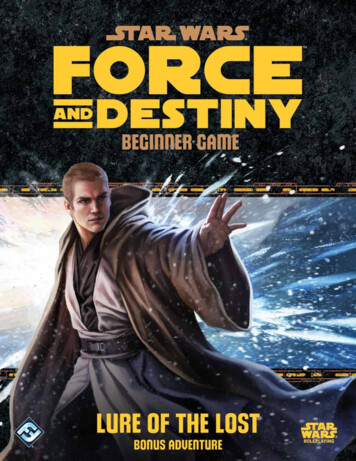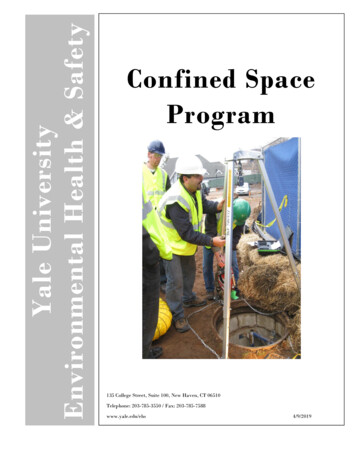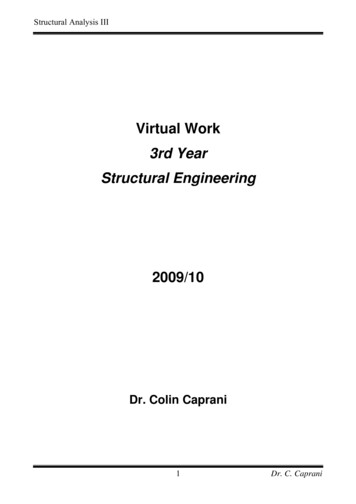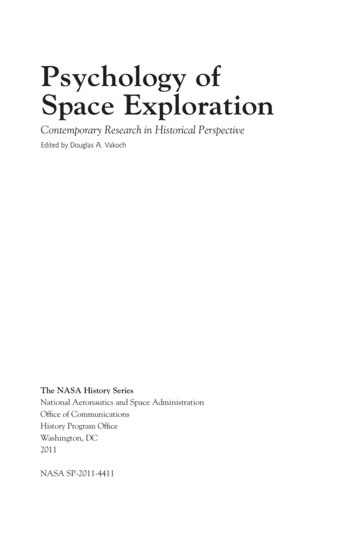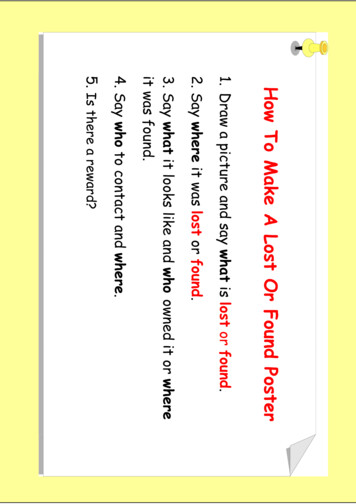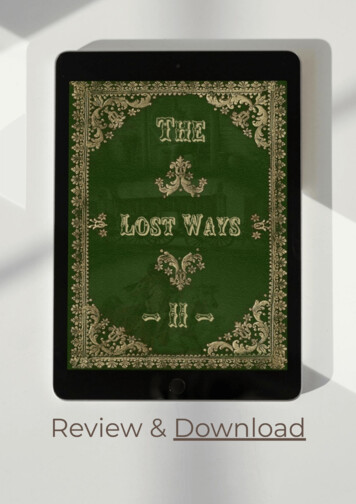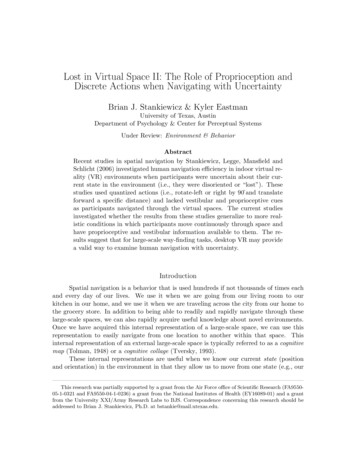
Transcription
Lost in Virtual Space II: The Role of Proprioception andDiscrete Actions when Navigating with UncertaintyBrian J. Stankiewicz & Kyler EastmanUniversity of Texas, AustinDepartment of Psychology & Center for Perceptual SystemsUnder Review: Environment & BehaviorAbstractRecent studies in spatial navigation by Stankiewicz, Legge, Mansfield andSchlicht (2006) investigated human navigation efficiency in indoor virtual reality (VR) environments when participants were uncertain about their current state in the environment (i.e., they were disoriented or “lost”). Thesestudies used quantized actions (i.e., rotate-left or right by 90 and translateforward a specific distance) and lacked vestibular and proprioceptive cuesas participants navigated through the virtual spaces. The current studiesinvestigated whether the results from these studies generalize to more realistic conditions in which participants move continuously through space andhave proprioceptive and vestibular information available to them. The results suggest that for large-scale way-finding tasks, desktop VR may providea valid way to examine human navigation with uncertainty.IntroductionSpatial navigation is a behavior that is used hundreds if not thousands of times eachand every day of our lives. We use it when we are going from our living room to ourkitchen in our home, and we use it when we are traveling across the city from our home tothe grocery store. In addition to being able to readily and rapidly navigate through theselarge-scale spaces, we can also rapidly acquire useful knowledge about novel environments.Once we have acquired this internal representation of a large-scale space, we can use thisrepresentation to easily navigate from one location to another within that space. Thisinternal representation of an external large-scale space is typically referred to as a cognitivemap (Tolman, 1948) or a cognitive collage (Tversky, 1993).These internal representations are useful when we know our current state (positionand orientation) in the environment in that they allow us to move from one state (e.g., ourThis research was partially supported by a grant from the Air Force office of Scientific Research (FA955005-1-0321 and FA9550-04-1-0236) a grant from the National Institutes of Health (EY16089-01) and a grantfrom the University XXI/Army Research Labs to BJS. Correspondence concerning this research should beaddressed to Brian J. Stankiewicz, Ph.D. at bstankie@mail.utexas.edu.
LOST IN VIRTUAL SPACE II2office) to another (e.g., our home) with relative ease. Furthermore, they can be used toplan routes between two known locations in which we have never traveled directly betweenbefore (e.g., we may have traveled from our home to the grocery store, and from our hometo our office, but we may have never travelled from our office to the grocery store).In addition to planning and traveling between known states within the environment,this internal representation is also useful for localizing ourselves within a familiar environment after becoming disoriented or “lost”. When one is lost in a familiar environment,one can represent this as a case of state uncertainty. That is, the observer has a certainamount of uncertainty about which position and orientation (state) that they are in withinthe large-scale space (such as a city or a complex building). By making observations withinthe environment (e.g., identifying buildings in a city, or seeing a painting in a building) andmaking actions (translating and rotating) observers can gather and integrate this information to reduce their uncertainty until there is none remaining.Previous studies by Stankiewicz, Legge, Mansfield, and Schlicht (2006) have investigated human navigation efficiency when participants are lost in virtual environments.Stankiewicz et al. (2006) investigated human navigation efficiency under a number ofconditions to try and determine how efficiently participants performed and determine thecognitive limitation that prevented participants from navigating optimally. To measure human navigation efficiency, Stankiewicz et al. (2006) developed an ideal navigator that wasbased upon a Partially Observable Markov Decision Process (POMDP) (Cassandra, Kaelbling, & Littman, 1994; Cassandra, 1998; Kaelbling, Cassandra, & Kurien, 1996; Kaelbling,Littman, & Cassandra, 1998; Sondik, 1971). The Stankiewicz et al. (2006) experimentswere conducted using desktop virtual reality. In these studies, participants observedthe environment from a first person perspective (see Figure 1 as an example of the typeof display used in these studies), but remained sitting and made button presses to movethrough the environment. In these studies participants did not have access to any egotheticcues1 that are typically available when navigating in the “real world”. Furthermore, participants moved by using quantized actions in the Stankiewicz et al. (2006) studies. In thesestudies they rotated left by 90 or right by 90 or moved forward a prescribed distance bymaking specific button presses. These quantized actions are not typical in the “real world”.Instead we move through space in a continuous manner. The studies described here investigated whether human efficiency changes as a function of whether participants haveaccess to egothetic cues or not and whether they move discretely or continuously throughthe environment.The results from Stankiewicz et al. (2006) suggest that the cognitive limitation in efficiently solving these tasks was in the participant’s inability to accurately update and maintain the set of states (positions and orientations) that they would be within the large-scalespace, given their previous actions and observations. The experiments described here investigated whether these effects generalize to more realistic conditions – specifically, whetherperformance will change with the addition of proprioceptive and vestibular information andthe use of continuous movements instead of discrete movements ( as used in the Stankiewiczet al. (2006) studies). To investigate this question we conducted a series of experiments thatused the same paradigm as Stankiewicz et al. (2006) but had participants navigate through1Egothetic cues are internal cues that provide information about the changes in position and orientationdue to changes in the vestibular system and proprioceptive cues from movement of the legs.
LOST IN VIRTUAL SPACE II3Figure 1. An image from the studies conducted by Stankiewiewicz et al. 2006. These studiesused indoor virtual environments in which participants navigated using key presses to move throughthe environment. The environments were visually sparse to produce a certain amount of stateuncertainty within the task.the environments using immersive technology in which participants navigated through thevirtual space using a head-mounted display in which their position and orientation wasalso tracked. This provided the participants with proprioceptive information that was notavailable to them in the desktop virtual reality environments.Using VR to Study Human Navigation AbilityOver the last few decades, virtual reality (VR) has been increasingly popular inpsychological applications. (e.g., see, Mallot & Gillner, 2000; Gillner & Mallot, 1998; R.Ruddle, Payne, & Jones, 1997; Steck & Mallot, 2000; Schölkopf & Mallot, 1995; Gillner& Mallot, 1998; Franz, Schölkopf, Mallot, & Bülthoff, 1998; Chance, Gaunet, Beall, &Loomis, 1998; Stankiewicz et al., 2006; Fajen & Warren, 2003). Psychologists have beenattracted to the ease of natural interaction with an environment without actually having to
LOST IN VIRTUAL SPACE II4construct it, which can save a great amount of time and money. In addition, the possibilityof manipulating the environment precisely and systematically now exists in a way that wasnever possible before.An issue that persists with virtual environments is whether the results obtained inVR environments are applicable to how people navigate in real environments. It appearsthat under some conditions, the results obtained in virtual environments do not generalizeto real environments but, under other conditions, the results do generalize.For example, one question that begins to address this issue is whether the knowledge acquired in a virtual environment transfers to the corresponding real environment.The argument is, that if the information transfers then this suggests that the underlyingrepresentation extracted in the VR environments simulates those that are generated in realenvironments. A number of researchers have investigated the transfer of knowledge from VRto real environments (e.g., see Darken & Banker, 1998; Koh, Wiegand, Garnett, Durlach, &Shinn-Cunningham, 1999; R. A. Ruddle & Jones, 2001; R. Ruddle et al., 1997; Thorndyke& Hayes-Roth, 1982; Waller, Hunt, & Knapp, 1998; Witmer, Bailey, & Kerr, 1996). Forexample, Witmer et al. (1996) investigated how well the knowledge acquired in virtual environments would transfer to real environments. In these studies, participants were trainedin either the real building, the virtual environment, or by using verbal directions and photographs from the real building. The virtual environment was rendered with high fidelity(the researchers carefully modeled the structure of the building along with the collection ofobject landmarks within the building). participants were trained on a specific route in oneof these conditions and then were instructed to take the same route in the real environment.They found that participants made fewer wrong turns and took less time to travel a complexroute when they were trained in the real environment than when they were trained in theimmersive virtual environment. However the number of wrong turns (immersive 3.3 versusReal 1.1) was small comparatively to the number of potential wrong turns (over 100).In another study by Koh et al. (1999) participants were given a 10-minute trainingsession in either the real building, an immersive VR display, or a desktop VR display.The immersive VR display consisted of a head-mounted display where movements throughthe environment were controlled by a joystick. The virtual environments were renderedwith high fidelity (the structure of the building was generated from architectural plans ofthe building and the walls were texture wrapped with photographs taken from the realenvironment). Koh et al. (1999) had participants estimate the direction and distancefrom one location to another unobservable location within the environment. They foundthat participants performed just as well when they were trained in the VR conditions(either immersive or desktop) as they did in the real environment. This result suggests thepossibility of generating an accurate spatial representation using virtual reality.Waller et al. (1998) also conducted a series of studies investigating how well participants transferred spatial knowledge about an environment when trained in the realenvironment, a map, desktop virtual reality, immersive virtual reality (two minute exposures to the VR environment) and long-immersive virtual reality (five-minute exposures tothe VR environment). In these studies, participants were trained by moving through theenvironment using one of these formats (or in the control condition participants were notgiven any training). After each training session, the participants were blindfolded and takento a “real” version of the environment. Participants were instructed to touch a series of
LOST IN VIRTUAL SPACE II5landmarks within the environment while blindfolded (these landmarks were shown in thetraining session). Waller, et al. recorded the time to complete the route blindfolded andthe number of times the participants bumped into the walls. Participants participated insix training/test sessions. In the first session, participants who were trained in the realenvironment performed significantly better than the participants who were trained in theother conditions. By the sixth session, performance for participants who were trained in thelong immersive condition was not significantly different than those participants who weretrained in the real condition.These studies suggest that under certain conditions the representation generated ina VR environment may transfer to real environments, suggesting that the representationsused in the two different spaces may be similar. However, other studies have shown thatunder more specific conditions human performance is different in virtual environment thanthey do in real environments. For example, Thompson et al. (2004) had participants judgedistances between two points in virtual and real environments. Participants consistentlyunderestimated the distances in the virtual environments relative to their measurementsin the real environments. These underestimations occured even when the displays werephotorealistic images. Furthermore (and perhaps more pertinent to the current studies)Chance et al. (1998) studied the effects of using egothetic cues when doing a dead-reckoningtask. In this task, participants would walk two edges of a triangle and then they were askedto walk to the starting point. In these studies they manipulated whether participants hadaccess to their vestibular cues (physical turning) or proprioceptive cues (locomotion). Thesecues were redundant with the visual cues that were given in the display. They found thatparticipants’ performances declined significantly when the vestibular cues were not availableto the participant. However, if the vestibular cues were available, but the proprioceptivecues were not, then participants performed just as well as if they had both egothetic cues.Summary: Utility of Using Virtual Reality. In summary, VR can be a powerful toolfor understanding issues associated with spatial navigation behavior. However, one needsto be careful when generalizing their results from tasks that are conducted in VR to spatialabilities in real environments. As is made clear by the previous examples, generalization mayor may not be appropriate. The current studies extend the work conducted by Stankiewiczet al. (2006). The current studies investigate the role of egothetic cues in addition toquantized actions when re-orienting oneself in a familiar environment.The effects of egothetic cues and continuous actionsThough there are many differences between the VR spaces used in the Stankiewiczet al. (2006) study and real environments the current paper focusses on two importantaspects. The first is the fact that participants did not have access to any egothetic cueswhile wayfinding in the original studies. Participants sat at a desktop computer and movedthrough the virtual space by pressing keys. The visual cues provided sufficient cues toidentify the amount of translation or rotation, but as has been shown in Chance et al.(1998), visual cues are not necessarily adequate for accurate spatial updating. To investigatethe effects of egothetic cues, we will have participants navigate using immersive technologyin which participants will walk through real space with visual information will be presentedto the participant on a head-mounted display (HMD).
6LOST IN VIRTUAL SPACE IIThe immersive condition will add egothetic cues that are not available in the desktopenvironment. However, it also changes the types of actions that participants can make.That is, in the immersive condition participants can move freely through the environment,or more specifically, their actions are continuous rather than discrete as in Stankiewicz etal. (2006). To investigate the use of continuous rather than discrete actions, we will alsorun participants in a condition in which they will move through the environment using ajoystick. In this condition, participants will not have access to their egothetic cues, but theywill move continuously through the space. Table 1 illustrates the three conditions used inthe current study and whether or not they have egothetic information or use continuousmotion.Table 1: An illustration of the three conditions used in this study and the specific manipulationsprovided by these conditions.Experiment ConditionsKey Press Joystick ImmersiveEgotheticContinuousNONONOYESYESYESTo address the effect of egothetic cues we will compare performance in the Joystickcondition to that of the Immersive condition. The primary difference when running withthe joystick versus the immersive environment is the egothetic cues. To investigate theeffects of continuous versus discrete actions we will compare performance in the Joystickversus the Key Press conditions. If quantizing the actions has an effect on human navigationperformance, there should be a change in efficiency in these two conditions.The Ideal NavigatorIn the studies conducted by Stankiewicz et al. (2006) and the current studies, participants navigated with a certain degree of uncertainty. In both of these studies, participantswere familiarized with a novel virtual environment2 . As illustrated in Figure 1, the environments are very sparse – that is, they did not contain any object landmarks (e.g., drinkingfountains, pictures, etc.). It should be pointed out that even with perfect perception, mostof the observations within the environment are not unique. Thus, given that the observers(human and ideal) are starting from a randomly selected state, in most trials they will startthe task with a certain amount of state uncertainty due to the fact that multiple states cangenerate the same observation. Stankiewicz et al. (2006) used a POMDP to formalize theideal navigator (also ,see Sondik, 1971; ?, ?; Cassandra, 1998; Kaelbling et al., 1996, 1998).To illustrate the POMDP approach in spatial navigation, we will provide a formal description of the underlying equations and provide an example using a simple environment. Thepurpose of this illustration with an example is to provide both an intuitive understanding ofhow the model works in addition to a formal understanding of the underlying mathematics.2Participants explored the environment until they could draw the environment correctly twice in a row
LOST IN VIRTUAL SPACE II7Figure 2. A simple map to demonstrate how the ideal navigator works. In this map the observercan be at any one of the green or red squares facing one of the four cardinal directions (N,S,E,W).The red square defines the “goal state” of that the observer wants to reach in the minimal numberof actions.For those who already understand the POMDP approach and/or are simply interested inthe empirical results can skip the following section on the Ideal Navigator.Defining the state and observation space. The ideal observer approach relies on converting a large continuous space into a quantized space. This is illustrated in Figure 2 asthe set of states that the observer could be in. In Figure 2 the observer can only be on oneof the red or green squares facing one of the four cardinal directions (North, South, East orWest). In this environment there are a total of 36 different states that the observer can bein (9 positions 4 orientations).For each of these states we can define the observation that is expected from thatstate3 . In Table 2 we have provided all of the observations and the states that could havegenerated that observation from the environment specified in Figure 2. As can be seenfrom this table, only four states (A1-E, C1-W, C3-W and A3-E) have unique views. All ofthe other states within the environment generate views that could be generated by at leastone other state. Thus, if one were to be randomly placed within the environment only 4times out of 36 (11% of the time) will the observer have no uncertainty about their location3Although with the current studies and the studies by Stankiewicz et al. (2006) the observations weredeterministic, one can actually model situations when the observations are noisy. That is, given a particularstate the probability of an observation is 1.0 for one observation and 0.0 for all others. However, one mighthave observation noise such that the probabilities are not 1.0 and 0.0 (for more see, Cassandra et al., 1994;Cassandra, 1998; Kaelbling et al., 1996, 1998; Sondik, 1971)
LOST IN VIRTUAL SPACE II8Table 2: The set of observations and the states that could generate that observation in the environment shown in Figure -Hall-RightHall/LeftHallHall (Dead End)Hall-RightHall (Right L-junction)Hall-LeftHall (Left ll (T-junction)Hall-RightHall-HallStatesA1-[N,S,W]; B1-N; C1-[N,E]; A2-[W,E,S]; B2-[E,W];C2-[W,E,S]; A3-[N,S,W]; B3-S; C3-[N,S,E]A1-EB1-S; B3-NC1-S; B3-[E,W]B1-E,A2-NB1-W;C2-NC1-W; A3-EB2-[N,S]C3-Wwithin the environment. When deciding what action to generate the observer must takeinto account the likelihood that they are in a particular state within the environment.Later we will use this table to generate the likelihoods that the observer is in a givenstate given its previous actions and observations (i.e., Belief Updating).Defining the transition matrix. In the original Lost in Virtual Space experiments(Stankiewicz et al., 2006) and the Keyboard condition in the current study, participantsmoved through the environment by making one of three actions: Rotate-Left 90 , RotateRight 90 and move Forward one hallway unit. The transition matrix defines the probability of the resulting state if the observer generates a particular action in a given state(i.e., p(s0 s, a)). An illustration of the transition matrix is shown in Table 3 and Figure3. This is a graphical representation of the transition matrix (and only a portion of thetransition matrix for the entire environment shown in Figure 2). As can be seen in Table 3the transition matrix makes explicit the resulting state given an initial state and a specificaction4 .Belief updating. Given the specifications of the observations and the specifications ofthe transition matrix one can begin to generate hypotheses about their current state withinthe environment given prior actions and observations. Equation 1 provides the Bayesianupdating rule that computes the likelihood of being in a specific state (s0 ) given the priorbelief, the current observation and the action just generated.4In the current studies and the studies conducted by Stankiewicz et al. (2006) the actions were deterministic. That is, the probability of the resulting state given an action and an initial state was 1.0 for one stateand 0.0 for all other states. One does not need to assume deterministic actions, but instead the resultingstate may be noisy. Modeling noisy actions can be found in Cassandra et al. (1994) and the other POMDPpapers listed.
9LOST IN VIRTUAL SPACE IITable 3: The complete transition matrix for the environment shown in Figure 2 with the threeactions Rotate-Left, Rotate-Right and Forward. The state on the far left of the table is the startingstate, and the three columns following the starting state specify the resulting state if the observerwere to generate that action.Initial -Ec3-SB3-W
LOST IN VIRTUAL SPACE II10Figure 3. A graphical representation of a part of the transition matrix for the environment shownin Figure 2. The arrows specify the resulting state if the observer was in one of the states andgenerated one of the three actions (Rotate-Left, Rotate-Right and move Forward). This transitionmatrix is only for a portion of the environment shown in Figure 2.p(o s0 , b, a)p(s0 b, a))(1)p(o b, a)b is the probability that the observer is in a state given the prior observations andactions. For this example, the likelihood of being in any given state is initially uniform (i.e.,p(s0 ) 1/36 0.0277).Let us assume that the initial observation (o) is ’Hall-RightHall/LeftHall’ (a Tjunction) from the environment in Figure 2. The probability of getting that observationgiven a specific state and the prior probabilities (p(o s0 , b)) is 0.0 for all of the states withthe exception of B2-N and B2-S. The value of p(o s0 , b) for these two states is 1.0.The probability of being in s0 given the prior probabilities is the prior probability ofbeing in that state (i.e., p(s0 b) 0.0277). Finally, the probability of getting the observationgiven the prior belief (p(o b)) is 0.055 or 2/36 (two states out of the 36 states give this sameobservation).p(s0 b, o, a) 1.0 0.27770.555 0.51.0 0.2777p(B2 S 0 Hall RightHall/Lef tHall0 ) 0.555 0.5p(B2 N 0 Hall RightHall/Lef tHall0 ) (2)(3)
LOST IN VIRTUAL SPACE II11We can extend this equation to give us the transition between beliefs after an actionis generated. That is τ provides us with the likelihood of the resulting belief vector givenour current belief vector and a specific action. (see fig. 4)τ (b, a, b0 ) Xp(o a, b)(4)o O p(s0 b,o,a)To illustrate the belief updating, we will use Equation (4) in addition to Table 3. Forthis example, let us assume that the observer generated the “Forward” action after its initialobservation and that after this action the observer’s observation is a “Wall”. For 21 of thestates the probability of seeing a wall is 1.0 (i.e., p(o s0 , b, o) 1.0). The probability of beingin a particular state given the prior belief (B2-N B2-S 0.5) and the action is 0.0 for all ofthe states with the exception of B3-S and B1-N. This can be shown by looking at Table 3and looking at the intersection of the “Forward” column (a “Forward”) and the B2-N andB2-S rows. This cell represents the resulting state given the action and initial state. Thusp(B1 N b, ‘F orward0 ) p(B1 N b, ‘F orward0 ) 0.5. The p(o b, a) 1.0. That is,given the current belief and a forward action, the probability of getting the observation of‘Wall’ is 1.0. Equation 5 makes this updating function more explicit.1.0 0.51.0 0.51.0 0.5p(B1 S b, ‘W all0 , ‘F orward0 ) 1.0 0.5p(B3 N b, ‘W all0 , ‘F orward0 ) (5)Now let us imagine that the observer’s next action is ‘Rotate-Right’ and following thisobservation it receives an observation of ‘Hall-RightHall’. Given the prior belief and theaction ‘Rotate-Right’, there are only two possible resulting states: B1-E and B3-W. Theobservation expected from B1-E is ‘Hall-RightHall’ while the observation expected fromB3-W is ‘Hall’ (see Table 2). The probability of observing ‘Hall-RightHall’ from B1-E is1.0, while the probability of getting this observation from B3-W is 0.0. Furthermore, theprobability of making either one of these two observations (p(o b, a)) is 0.5. As can be seenin Equation 6 the probability of being in B1-E is now 1.0 and the probability of being inB3-W is 0.0.1.0 0.50.5 1.00.0 0.5p(B3 W b, ‘Hall RightHall0 , ‘Rotate Right0 ) 0.5 0.0p(B1 E b, ‘Hall RightHall0 , ‘Rotate Right0 ) (6)With this observation we can see that all of the probabilities collapse onto the stateB1-E – that is the observer has completely disambiguated itself within the environment.
LOST IN VIRTUAL SPACE II12Reward structure. Equation 1 formalizes how one would update their belief abouttheir current state given their previous actions, observations and prior probabilities. However, it does not specify which action that the observer should take. In order to specify theoptimal action one must specify a Reward Structure for the problem. A reward structurespecifies the expected value (both positive and negative rewards) for generating an actionin a particular state. For example, in Stankiewicz et al. (2006) the reward for generating a“Forward”, “Roate-Left” and “Rotate-Right” action was the same (-1.0). This reward wasthe same for all of the states that the observer could be in.However, for the experiments described here and the experiments in Stankiewicz etal. (2006) there was a goal state that the observers were attempting to reach. In theenvironment in Figure 2 the goal is C2-[N,S,E,W]. That is, the goal is to reach C2 facing inany particular direction. In order to model this we need to add a new action to the threeshown in Figure 3. We will call this action ‘Declare-Done’. We will assign a reward of 100when this action is generated and the observer is in C2-[N,S,E,W] and -500 for all of theother states.Given an explicit reward structure, one can begin to formalize the optimal action,given a specific belief about one’s current state in the environment. In the following section,we will formalize how the optimal action can be selected given the current belief, transitionmatrix, and reward structure.Choosing the optimal actionUsing the Transition matrix, Reward Structure and Observation Matrix we can compute the optimal action for any given belief vector that the observer might have5 . Tocompute the optimal action one must consider the immediate reward for generating a specific action in a specific state in addition to computing the future expected rewards. Thefollowing equation is the reward for generating a single action given that you have a particular belief vector (b). Figure 4 illustrates the set of actions that are available to theobserver and the expected immediate rewards for generating each action (the equation forcomputing the immediate reward is in Equation 7).ρ(b, a) XR(s, a)b(s)(7)s Sρ provides the immediate reward for making the action a and Figure 4 provides anillustration for the current example. As can be seen in Figure 4, t
possibility of generating an accurate spatial representation using virtual reality. Waller et al. (1998) also conducted a series of studies investigating how well par-ticipants transferred spatial knowledge about an environment when trained in the real environment, a map, desktop virtual reality, immersive virtual reality (two minute expo-
